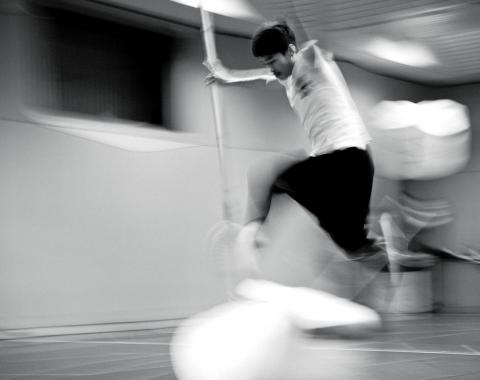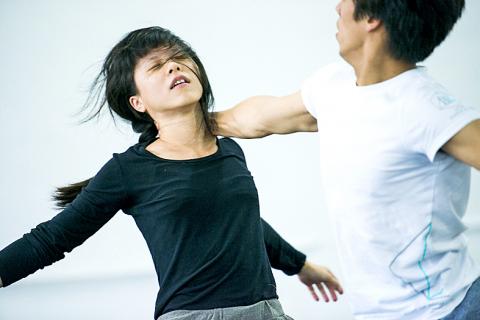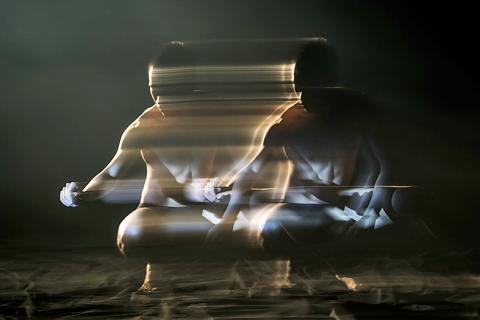The National Theater Concert Hall’s four-year-old 1+1 Dance Series, an annual double bill featuring two choreographers whose small companies rarely command the National Theater’s main stage, returns this weekend.
This year’s program also continues the series’ format of pairing an established company with a younger one. Ku Ming-shen’s (古名伸) Ku & Dancers (古舞團) will perform Sadhu (沙度), while Bulareyaung Pagarlava’s Bulareyaung Dance Company (BDC,布拉瑞揚舞團台北首演) will perform his latest work, Qaciljay (阿棲睞).
The 60-minute Sadhu is a fairytale about modern life. It centers on a girl in red and a giant puppet, the aforementioned Sadhu — which is moved by 10 dancers — that the girl has created as she seeks to deal with her anxieties, stress and negative emotions. With Sadhu, the girl can explore her imagination and discover solutions to the problems that she encounters.

Photos Courtesy of Ku & Dancers
Like all fairytales, Sadhu has a message. Ku explores the triggers for anxiety and fear to show how to work through and reconcile those doubts through communication and trust. One might even say she is showing how to dance through life.
The show is strong reminder, if one was needed, that Ku, who is a well-known proponent of Contact Improvisation, can do more structured, narrative works as well.
She founded her company 23 years ago to develop and promote improvisation in dance. Contact improvisation focuses on the physics of motion and contact between bodies; it is about dialogue and communication. Ku sees improvisation as a force that can draw people together and encourage trust and understanding while exploring the abstractness of dance.

Photos Courtesy of Ku & Dancers
Ku is no stranger to National Theater commissions, having been tapped by its programming team several times over the past two decades to create new works, while this will be the first appearance of Bula’s year-and-a-old BDC, although Cloud Gate Dance Theatre (雲門) performed his one of his works at the National Theater a decade ago, the powerful and disturbing Formosa, Island the Beautiful (美麗島).
Bula, who got his start as a choreographer with Cloud Gate 2 (雲門2) 16 years ago, has in recent years focused on pursuing and exploring indigenous themes in his works, especially those of his Paiwan culture.
With Qaciljay, which means rock in the Paiwan language, Bula expands on a show style featured in his work last year, La Ke (拉歌), which fused Aboriginal songs and storytelling with free-form dancing and modern choreography.

Photos courtesy of Bulareyaung Dance Company
While Ku’s piece is about dealing with the pressures of modern life, Bula’s is about pressures of history and traditional culture.
Qaciljay, set on eight men, explores the “singing body” and why indigenous people sing when walking in the mountains. Bula sees singing as another way of moving the body, of using the body to send communicate with others and to learn about ourselves.
At a news conference for the show, Bula noted that rocks and stones, when they roll down a hill or mountainside into a valley, it is not the end of their journey, but the beginning of new existence.

Photos courtesy of Bulareyaung Dance Company
Saturday night’s “1+1” show is almost completely sold out, while about 150 seats are left for Sunday’s matinee. The program comes with an audience advisory that there will be partial nudity.
Ku & Dancers will also perform Sadhu as a standalone program on June 11 in Tainan as part of the Tainan Arts Festival.

Exceptions to the rule are sometimes revealing. For a brief few years, there was an emerging ideological split between the Democratic Progressive Party (DPP) and Chinese Nationalist Party (KMT) that appeared to be pushing the DPP in a direction that would be considered more liberal, and the KMT more conservative. In the previous column, “The KMT-DPP’s bureaucrat-led developmental state” (Dec. 11, page 12), we examined how Taiwan’s democratic system developed, and how both the two main parties largely accepted a similar consensus on how Taiwan should be run domestically and did not split along the left-right lines more familiar in

As I finally slid into the warm embrace of the hot, clifftop pool, it was a serene moment of reflection. The sound of the river reflected off the cave walls, the white of our camping lights reflected off the dark, shimmering surface of the water, and I reflected on how fortunate I was to be here. After all, the beautiful walk through narrow canyons that had brought us here had been inaccessible for five years — and will be again soon. The day had started at the Huisun Forest Area (惠蓀林場), at the end of Nantou County Route 80, north and east

Specialty sandwiches loaded with the contents of an entire charcuterie board, overflowing with sauces, creams and all manner of creative add-ons, is perhaps one of the biggest global food trends of this year. From London to New York, lines form down the block for mortadella, burrata, pistachio and more stuffed between slices of fresh sourdough, rye or focaccia. To try the trend in Taipei, Munchies Mafia is for sure the spot — could this be the best sandwich in town? Carlos from Spain and Sergio from Mexico opened this spot just seven months ago. The two met working in the

This month the government ordered a one-year block of Xiaohongshu (小紅書) or Rednote, a Chinese social media platform with more than 3 million users in Taiwan. The government pointed to widespread fraud activity on the platform, along with cybersecurity failures. Officials said that they had reached out to the company and asked it to change. However, they received no response. The pro-China parties, the Chinese Nationalist Party (KMT) and Taiwan People’s Party (TPP), immediately swung into action, denouncing the ban as an attack on free speech. This “free speech” claim was then echoed by the People’s Republic of China (PRC),